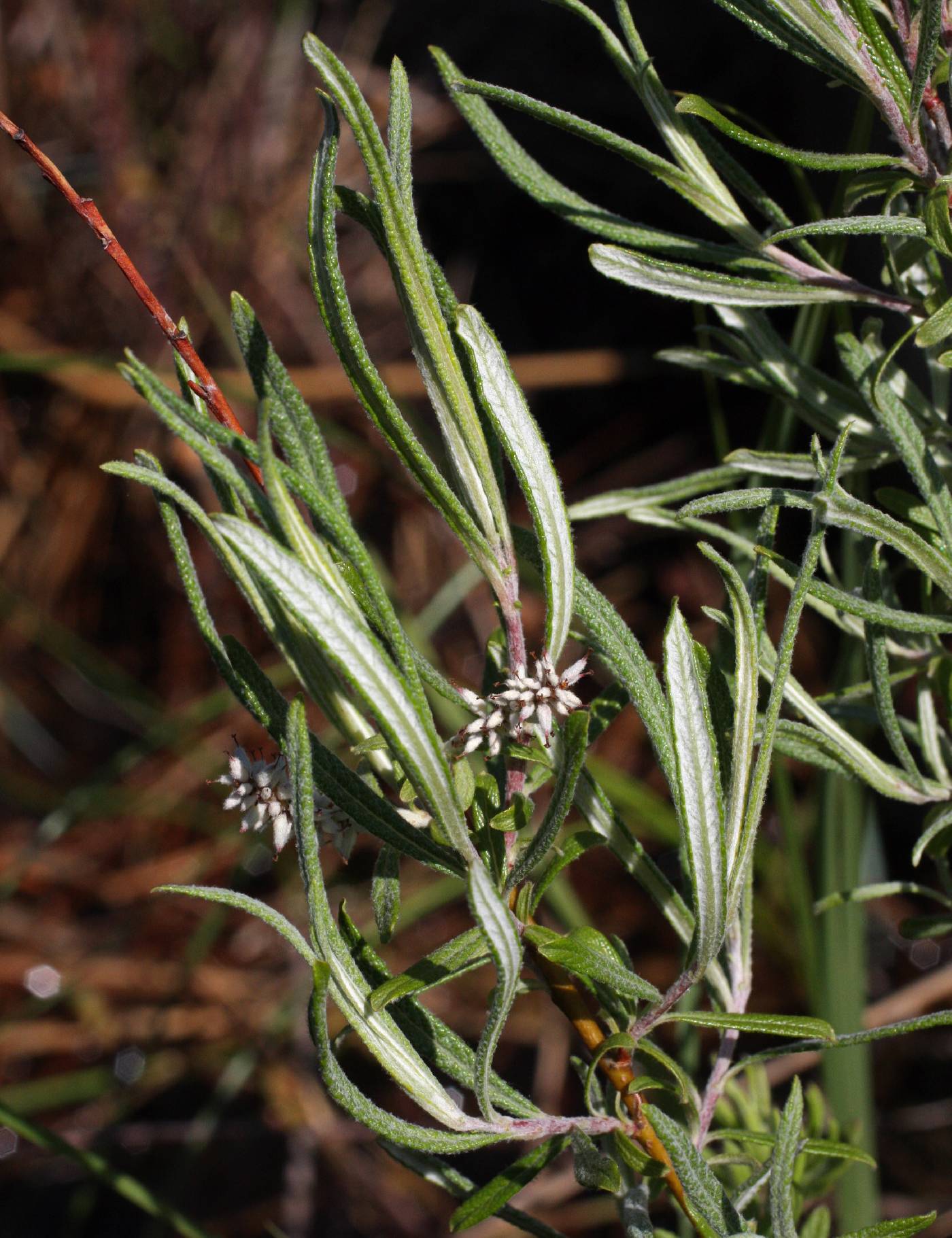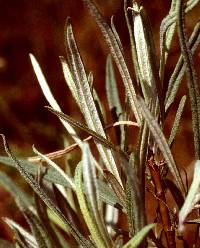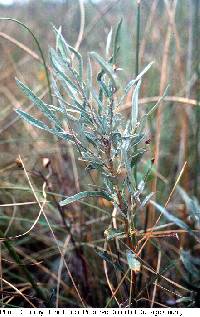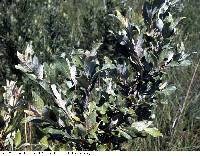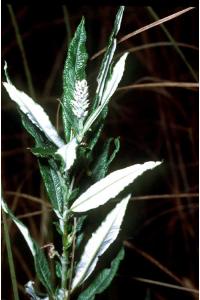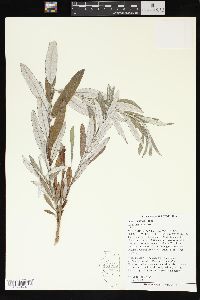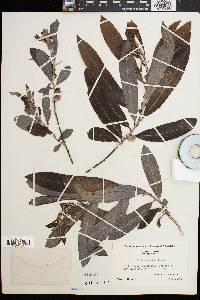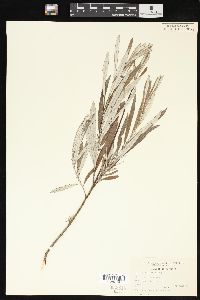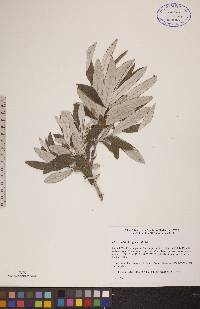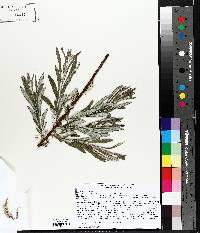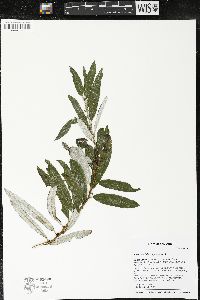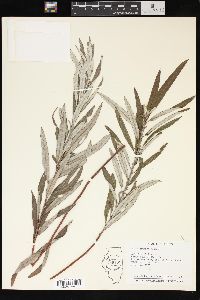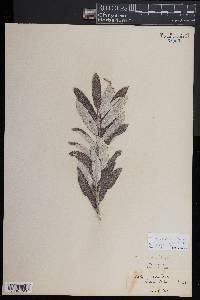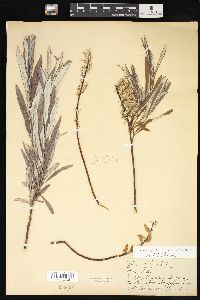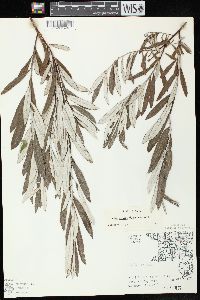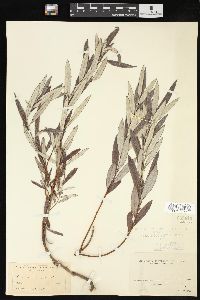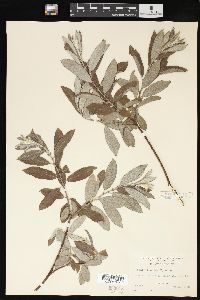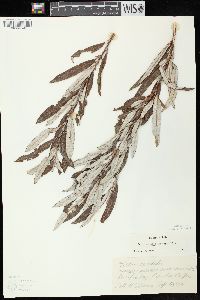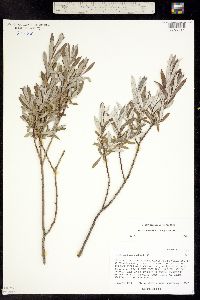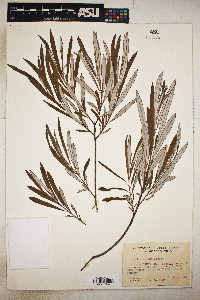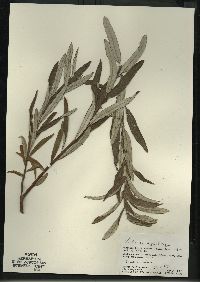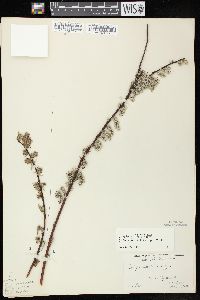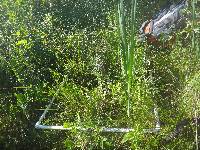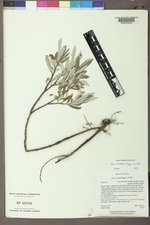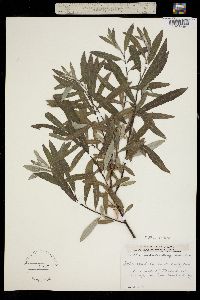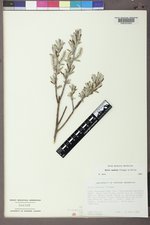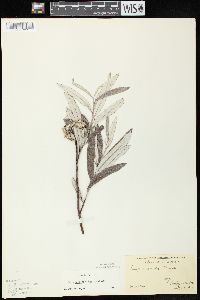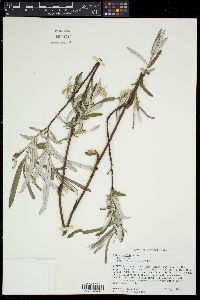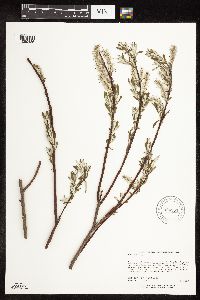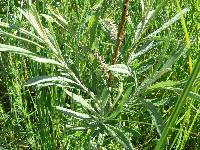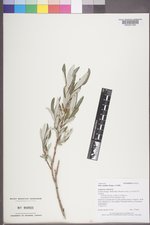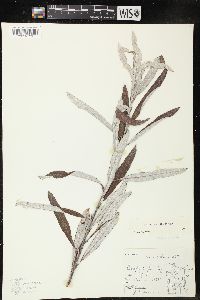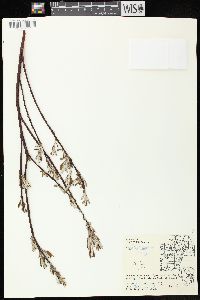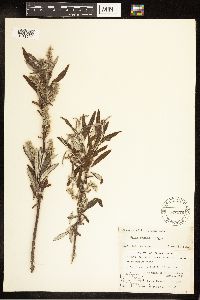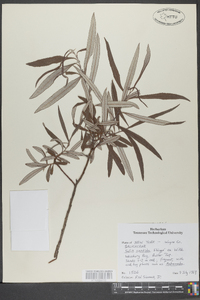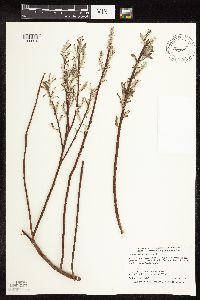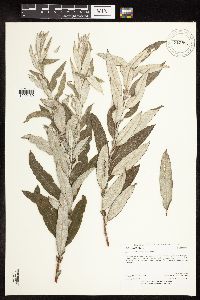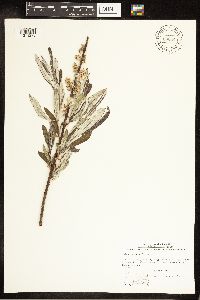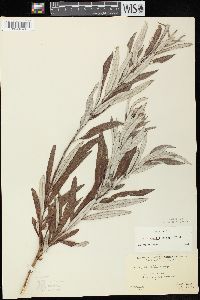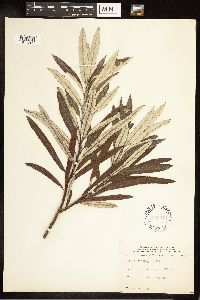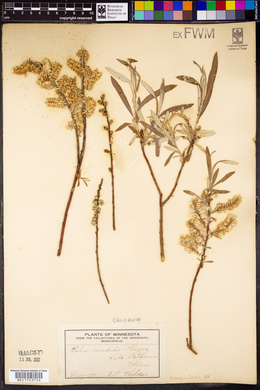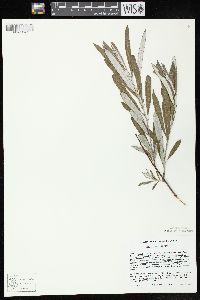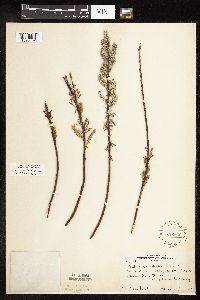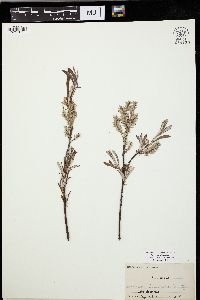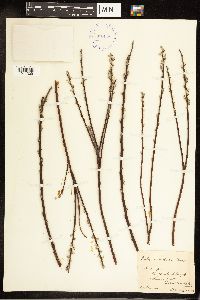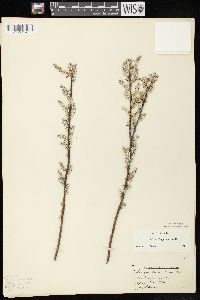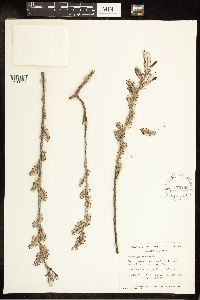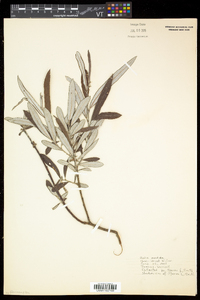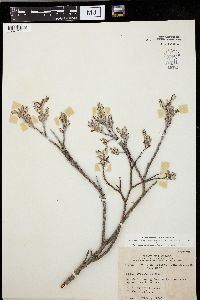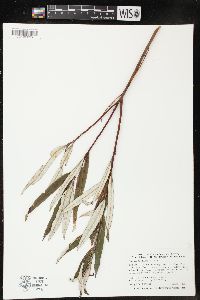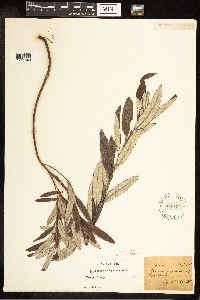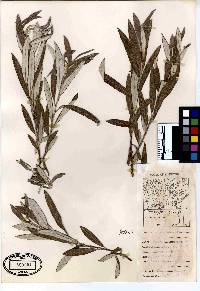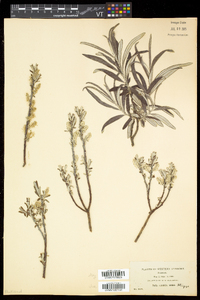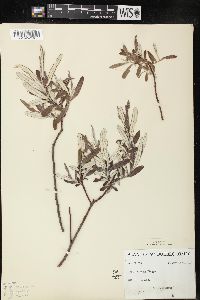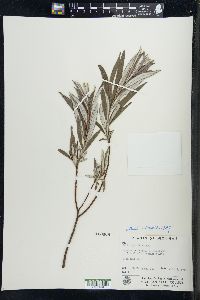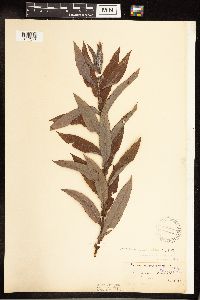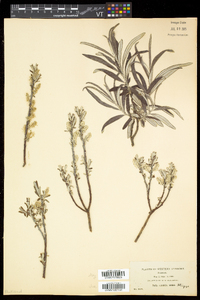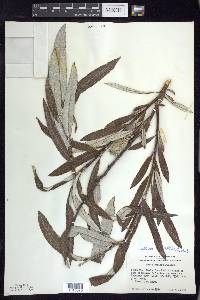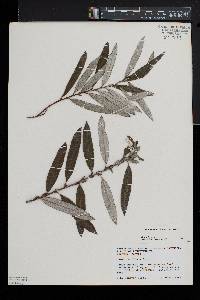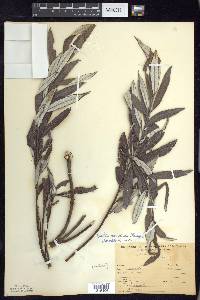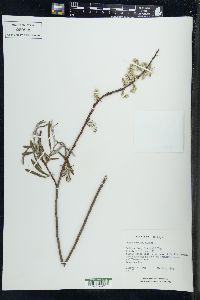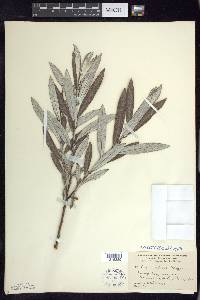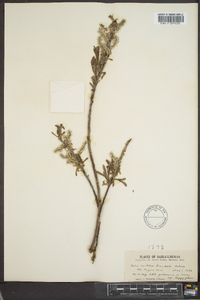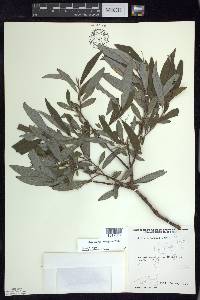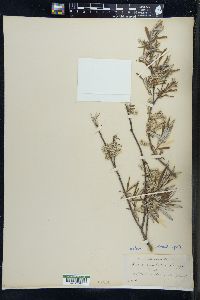
|
|
|
|
Family: Salicaceae
Sage Willow, more...sageleaf willow
[Salix candida f. denudata (Andersson ex DC.) Rouleau, moreSalix candida var. denudata Andersson in DC., Salix candida var. tomentosa Andersson in DC., Salix candidula Nieuwland] |
Plants often forming clones by layering. Stems: branches dark gray-brown to yellow-brown, not glaucous, woolly in patches or floccose to glabrescent; branchlets yellow-brown to red-brown or gray-brown, densely (white) woolly or tomentose, sometimes floccose. Leaves: stipules rudimentary or foliaceous on early ones, late ones 2-3.6 mm, apex acute; petiole shallowly to deeply grooved adaxially, 3-10 mm, tomentose or densely (white) woolly adaxially (obscured by hairs); largest medial blade lorate, narrowly elliptic or oblanceolate, 47-103 × 5-20 mm, base convex or cuneate, margins strongly to slightly revolute, entire, or sinuate, apex acute or convex, abaxial surface glaucous (generally obscured by hairs), very densely to sparsely tomentose-woolly (cobwebby in age), hairs dull white, crinkled, adaxial dull or slightly glossy, moderately densely to sparsely tomentose, floccose, hairs dull white; proximal blade margins entire; juvenile blade yellowish green, very densely tomentose abaxially, hairs white. Catkins flowering as leaves emerge; staminate stout or subglobose, 17-39 × 8-16 mm, flowering branchlet 0.5-7 mm; pistillate densely to moderately densely flowered, stout or slender, 20-66 × 9-18 mm, flowering branchlet 1-24 mm; floral bract tawny or brown, 1.2-1.8 mm, apex rounded or acute, abaxially hairy, hairs straight to wavy. Staminate flowers: adaxial nectary narrowly oblong to oblong, 0.6-1 mm; filaments distinct or connate less than 1/2 their lengths; anthers purple turning yellow, ellipsoid, long-cylindrical, or globose, 0.4-0.6 mm. Pistillate flowers: adaxial nectary oblong, 0.4-1 mm; ovary pyriform, beak sometimes slightly bulged below styles; ovules 12-18 per ovary; styles 0.3-1.9 mm. Capsules 4-6 mm. 2n = 38. Flowering mid Apr-early Jul. Floodplains, marl bogs, fens, and meadows, calcareous substrates; 10-2800 m; St. Pierre and Miquelon; Alta., B.C., Man., N.B., Nfld. and Labr., N.W.T., N.S., Nunavut, Ont., P.E.I., Que., Sask., Yukon; Alaska, Colo., Conn., Idaho, Ill., Ind., Iowa, Maine, Mass., Mich., Minn., Mont., N.H., N.J., N.Y., N.Dak., Ohio, Pa., S.Dak., Vt., Wash., Wis., Wyo. Occurrence of Salix candida in Nunavut is on Akimiski Island in James Bay. Salix candida is geographically wide-ranging but limited to calcareous habitats and, for that reason, it is quite local or even rare in some parts of its range. Hybrids: Salix candida forms natural hybrids with S. bebbiana, S. brachycarpa var. brachycarpa, S. calcicola, S. eriocephala, S. famelica, S. myrtillifolia, S. petiolaris, and S. planifolia. Hybrids with S. discolor, S. petiolaris, and S. sericea have been reported (the latter also by C. K. Schneider 1921; M. L. Fernald 1950) but no convincing specimens have been seen. Salix candida hybrids are recognized from their woolly indumentum that often is conspicuous on leaves, stems, and ovaries. In hybrids, these characters, especially woolly patches on ovaries, stand out as discordant variation. Salix candida × S. eriocephala (S. ×rubella Bebb ex C. K. Schneider) was described by W. W. Rowlee and K. M. Wiegand (1896) as S. candida × S. cordata. In addition to woolly patches on the ovaries, they noted that buds of the hybrids usually are shorter, more divergent, and blunter than those in S. eriocephala, and are glabrous or hairy. Known from New York and Newfoundland; it should be expected throughout the sympatric range of the parental species. Salix candida × S. famelica: The Saskatchewan specimen resembles S. famelica but has the leaf indumentum of S. candida. Salix candida × S. myrtillifolia: Saskatchewan specimens combine characters of the two parents. Salix candida × S. petiolaris: Intermediates between these species are known from Michigan and New York (W. W. Rowlee and K. M. Wiegand 1896) as well as Ontario and Saskatchewan, but can be expected wherever the two grow together. The invalid name 'S. ×clarkei' is sometimes used for this hybrid. The glabrescent form of Salix candida, forma denudata (Andersson) Rouleau, may be of hybrid origin.
Small shrub 0.5 - 3 m tall Leaves: alternate, on 5 - 8 mm long, hairy leafstalks, dull green above, densely white-woolly beneath, 5 - 10 cm long, 1 - 2.5 cm wide, narrowly elliptic to narrowly egg-shaped with a tapering base and pointed tip, revolute (rolled downward along the margins), nearly non-toothed, and glandular. The blade also exhibits impressed veins above and a yellowish midrib beneath. Occasionally the leaves may become less hairy later in the year, with hairs tending to crowd along the veins beneath. Flowers: either male or female, borne on separate trees (dioecious) in cylindrical catkins. The catkin grows on a short, leafy stalk. Female catkin to 2 - 3 cm long with brown scales and hairy, red styles. The ovary is conical and densely hairy. Male catkin 1 - 2 cm long and hairless. Stamens two, with red anthers. Fruit: a capsule, in elongated clusters, short-stalked, greenish to light brown, 5 - 8 mm long, flask-shaped, and hairy. Seeds have long, white, silky hairs attached. Twigs: densely white- to gray-woolly. Similar species: In the Chicago Region, Salix candida differs from most other willows by having hairy leaf undersides and downward-rolled (revolute) leaf margins that are not distinctly toothed. The similar S. caprea and S. cinerea (rare escapes not found in bogs) grow over 2 meters tall and have relatively wider leaves. Flowering: late April to late May, with the leaves Habitat and ecology: In the Chicago Region, Salix candida is local in bogs. It is also found in prairie marshes and fens. Occurence in the Chicago region: native Notes: Occasional specimens have been observed which seem to be intermediate between Salix candida and S. humilis. Generally, the leaf margins of such specimens are scarcely down-curved, and lower leaf surfaces are uniformly covered with grayish white hairs rather than having concentrated patches. A very ornamental shrub. Etymology: Salix is the Latin word for willow. Candida means shining or pure white. Author: The Morton Arboretum Freely branched low shrub to 1(-1.5) m; branches divaricate, brownish, glabrous, full of lf-scars; twigs densely white-tomentose; stipules lanceolate, glandular; lvs linear- oblong, oblong, or narrowly to rarely broadly oblanceolate, 4-8(-12) נ0.7-1.5(-2.5) cm, mostly acute at both ends, revolute, entire to glandular-crenate, dull and thinly tomentose with sunken veins above, densely white-tomentose beneath; catkins with the lvs, 1-5 cm, on leafy-bracted peduncles 0.5-2 cm; scales 1.5-2.5 mm, brown, persistent, woolly-villous; stamens 2; frs lanceolate, 5-8 mm, subsessile, white-tomentose; style 1-1.5 mm; 2n=38. Calcareous wetlands in glaciated areas; Lab. to Alas., s. to N.J., Pa., O., Ind., Ill., Io., and Colo. An extreme form with most of the tomentum of the lvs soon deciduous, the lvs glaucous beneath, is f. denudata (Andersson) Rouleau. A hybrid with no. 17 is S. زubella Bebb; one with no. 28 [Salix petiolaris Sm.] is S. أlarkei Bebb. Gleason, Henry A. & Cronquist, Arthur J. 1991. Manual of vascular plants of northeastern United States and adjacent Canada. lxxv + 910 pp. ©The New York Botanical Garden. All rights reserved. Used by permission. From Flora of Indiana (1940) by Charles C. Deam This is an infrequent low willow in the bogs of the northern part of the lake area. It is generally found with sedges, cranberry, and bog-rosemary. [Variety denudata] differs from the species in having narrower leaves, which are glabrate or glabrescent on both sides, especially above, and sometimes glaucescent beneath. I have only one specimen from a bog on the south side of Pigeon River about 2 miles east of Mongo, Lagrange County. …… Indiana Coefficient of Conservatism: C = 10 Wetland Indicator Status: OBL |

